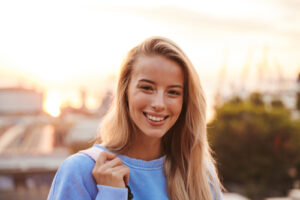Do your eyes feel dry, itchy, or irritated? These are some of the symptoms that come with a condition called dry eye syndrome.
Dry eyes occur when you don’t produce enough tears or the tears produced are of poor quality. Keep reading to learn more about dry eyes and determine if treating them with intense pulsed light therapy can help!
Why Do My Eyes Feel So Dry?

Tears consist of three layers that make up the tear film: water, mucus, and oil. The mucus spreads your tears evenly over the surface of your eye, while oil prevents moisture and water in your eyes from evaporating too quickly.
If your tears don’t spread evenly or evaporate faster, you may experience dry eye symptoms. Some of the common symptoms of dry eye are:
- Itching
- Eye pain
- Excessive tearing
- Increased sensitivity to light
- Eye fatigue
- Difficulty wearing contacts
- Burning sensation
- Red eyes
- Stringy mucus around and in the eyes
Severe dry eye can be highly uncomfortable and can result in blurry vision. If you experience blurry vision, this interferes with your ability to complete routine activities like driving, using the computer, and reading.
When you don’t treat dry eyes, they can damage the cornea, eventually leading to vision loss and blindness. Luckily, all these problems are avoidable by seeking effective dry eye treatment.
There are different causes of dry eye, including:
Meibomian Gland Dysfunction
Meibomian gland dysfunction (MGD) happens when the oil or meibomian glands in your eyes become blocked. If this occurs, it leads to poor-quality tears.
Inflammatory Disorders

Inflammatory disorders like blepharitis and rosacea result in inflamed eyelids, affecting the meibomian glands.
Reasons to Consider Intense Pulsed Light Therapy
Dry eye treatments such as artificial tears, eyelid scrubs, eye drops, and hot compresses only offer temporary relief rather than addressing the source of the condition. Undergoing a treatment like intense pulsed light therapy IPL) targets the root cause of the problem.
Doing so relieves dry eye symptoms and slows or stops the progression of dry eye.
How Intense Pulsed Light Therapy Treats Dry Eyes

Intense pulsed light therapy heats and dissolves clogged oil, making your eyes feel dry and irritated. Releasing the clogged oil helps remove it and releases it into your tear film.
The intense pulsed light also helps clear obstructed meibomian glands, restoring function. As a result, you begin producing an adequate amount of oil, protecting your tears from drying out too fast.
Eyelid Mites Can Cause Dry Eyes
Also, mites found in your lashes can cause dry eyes. While small amounts are not harmful, an increase in the number of mites that feed on oil secretions from the meibomian glands can lead to eyelid inflammation in addition to dry eyes. Many patients with ocular or facial rosacea have many eyelid mites that often block the meibomian glands and cause meibomian gland dysfunction.
IPL effectively treats dry eyes due to lash mites by getting rid of or reducing the mites. Patients with rosacea usually have abnormally dilated vessels along the margins of their lids. The dilated blood vessels increase eyelid inflammation and can induce MGD.
Inflammation of the eyelids might also affect tear quality and trigger dry eye symptoms such as grittiness and redness. Intense pulsed light therapy treatment targets and destroys the abnormal vessels, reducing inflammation.
Eyelid and skin inflammation are relieved after 1 to 3 treatment sessions. But you’ll need about 4 to 8 IPL therapy sessions to treat dry eye, depending on your specific symptoms and the severity of your condition.
Your eye doctor will advise you to maintain scheduled sessions, say once every 6 to 12 months, for optimal and lasting results.
What to Expect During Intense Pulsed Light Therapy
Before treatment begins, you’ll undergo an initial consultation with your ophthalmologist. The consultation will allow your eye doctor to diagnose your dry eye correctly and create a highly individualized treatment plan.
If you’re a good candidate for IPL, treatment may start immediately. Your ophthalmologist will apply coupling gel and gentle light pulses on the treatment area.
To ensure the safety of your eyes, you’ll wear IPL protective pads or goggles as treatment is being administered. The pulsed light might feel warm, and your skin may redden post-treatment.
However, the redness disappears after a few hours. The whole process takes approximately 15 minutes to complete.
You can go home once your session is over and resume your normal activities. Before leaving, your eye doctor will advise you to follow a strict after-care routine.
Taking Care of Your Eyes After Intense Pulsed Light Treatment
Your eye doctor will recommend you:
- Stay out of the sun for about a week
- Apply sunscreen that’s SPF 50 4 times a day whenever you’re outside
- Avoid scratching the treatment area
- Take all medication exactly as prescribed
- Stay away from harsh scrubs or cleansers for two weeks
It’s usual to have mild swelling for the first five days. However, it’s concerning if you experience symptoms like hypersensitivity to the sun or excessive eye strain. Contact your eye doctor immediately if this occurs.

Top of the Line Dry Eye Treatment
Having chronically dry eyes can lower your quality of life. Fortunately, the experienced ophthalmologists at Joshi Eye Institute can help.
Our expert team of ophthalmologists will accurately diagnose dry eyes and get you started on intense pulsed light therapy if you’re a suitable candidate. Starting IPL will stop your dry eyes from worsening and give you some much-needed relief.
Have you tried different dry eye treatments with little success? Schedule an appointment at Joshi Eye Institute in Boynton Beach, FL, today! There’s no reason to keep living with the frustrations of dry, irritated eyes anymore.



